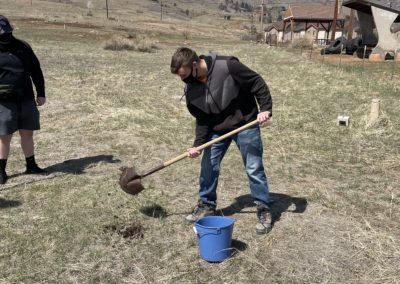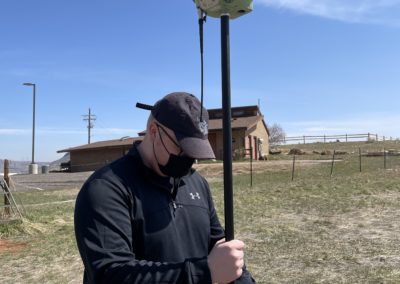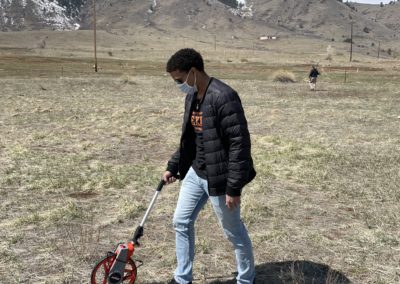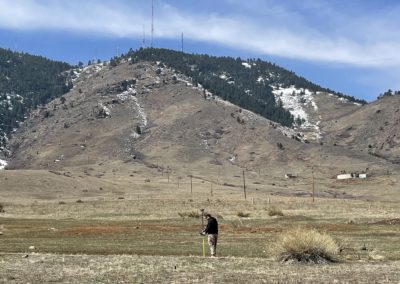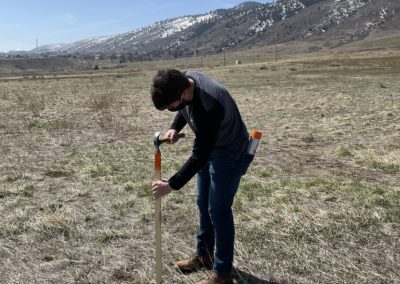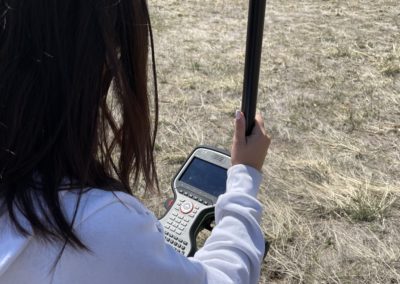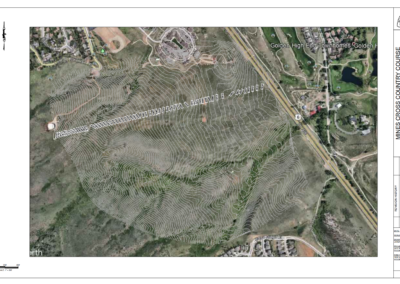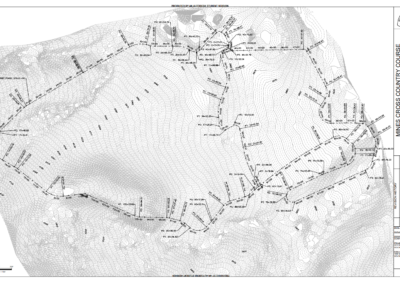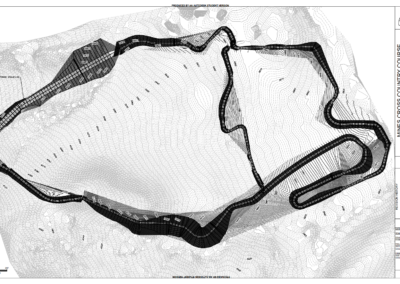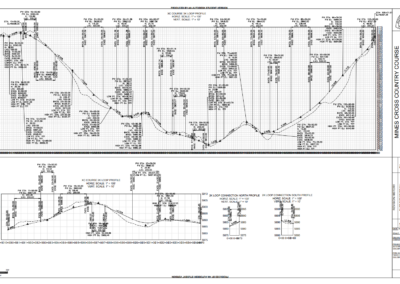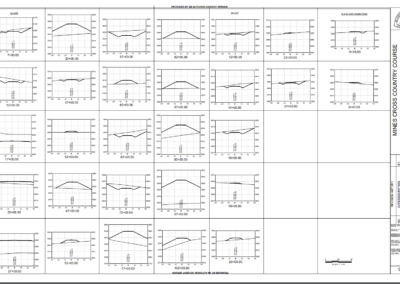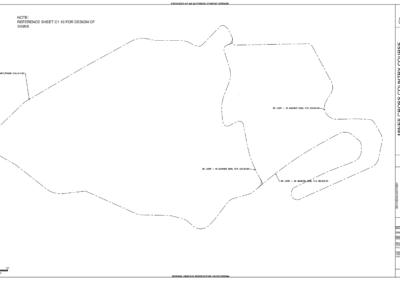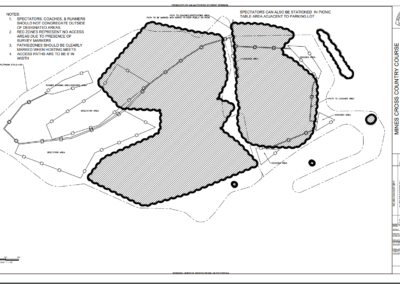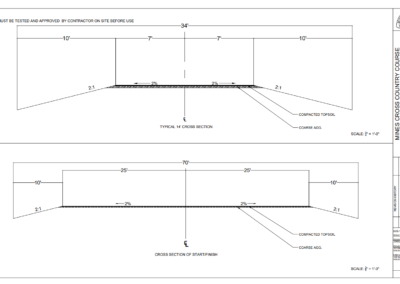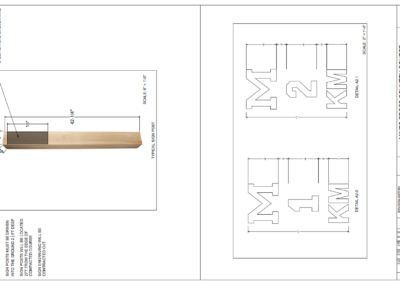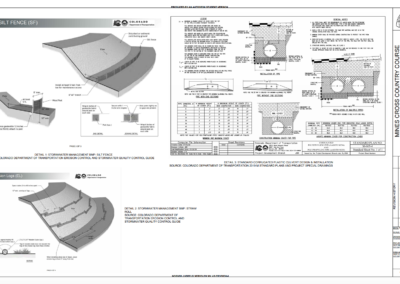Mines Cross Country Course
Overview
Over the past five years, the Colorado School of Mines Athletic Department has made considerable renovations to the athletic facilities. The Department has constructed a new football facility, soccer facility, as well as new baseball and softball fields. As Mines continues to enroll more student athletes that continue to perform at the highest level, the need for new athletic facilities becomes paramount.
The Colorado School of Mines Athletic Department has tasked a team of Civil Engineering students to design a 2-kilometer and 3-kilometer cross-country course on the existing Colorado School of Mines Survey Fields, located to the south of Mines Park. The course will be used by the Mines Cross-Country Team for daily practice, conference meets, and has the potential to be selected for NCAA Regional Championship meets. Additionally, the course was designed to be used by the entire community of Golden. The project took into consideration the existing stakeholders of the site and ensured that the areas used for academic instruction were avoided and not significantly altered or intruded by the course. The 2-kilometer and 3-kilometer loops provide a competitive and challenging course which has been designed to the NCAA standards and is capable of hosting any level of meet from a regular season conference meet to a NCAA Regional Championship.
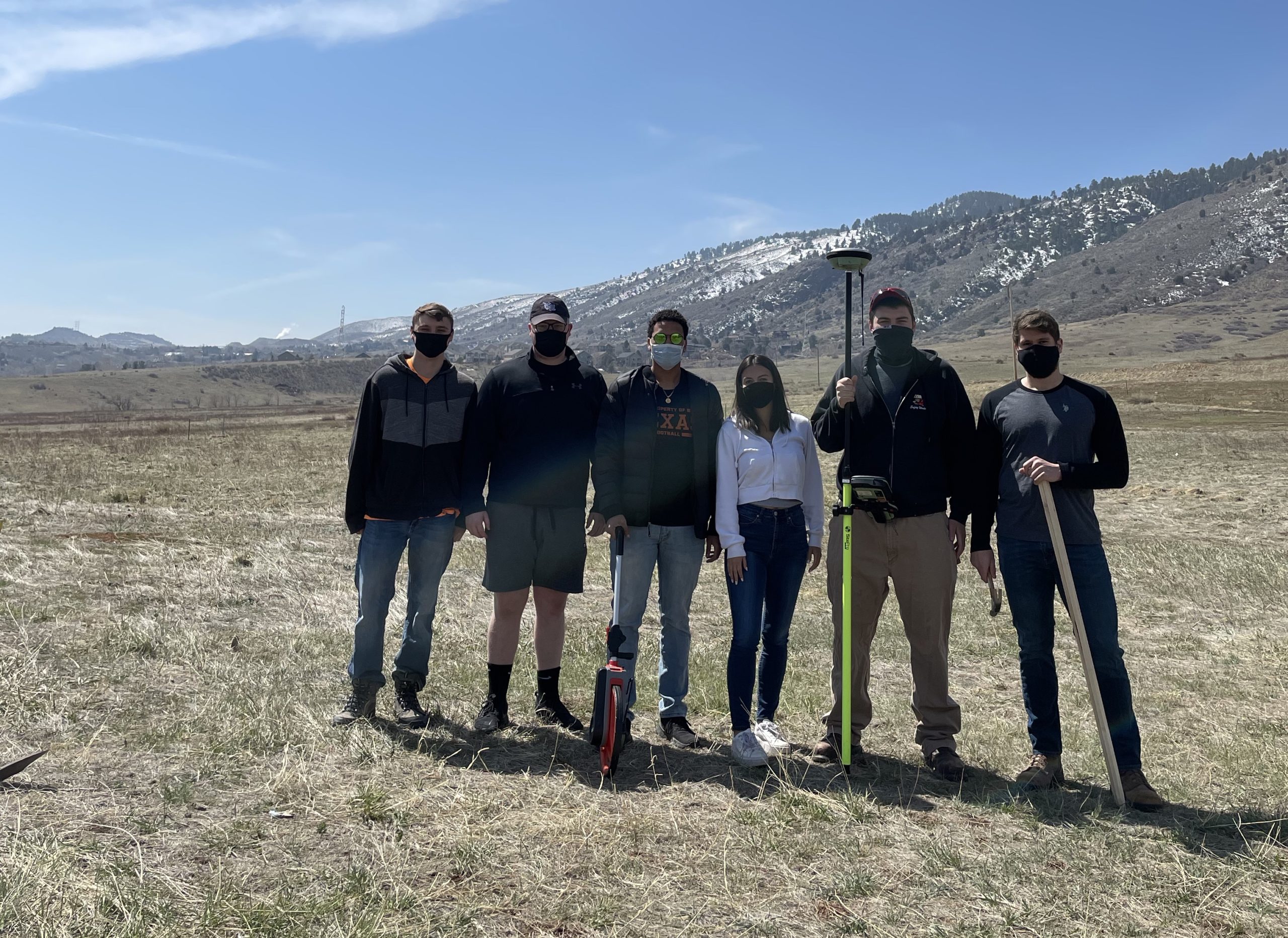
Live Zoom Chat
Use the link below to join us live from 8:00 – 10:30 a.m. on April 29.
Please use passcode: 414954
Or iPhone one-tap: 16699006833,98330187400# or 12532158782,98330187400#
Or Telephone:
Dial: +1 669 900 6833 (US Toll) or +1 253 215 8782 (US Toll)
Meeting ID: 983 3018 7400
Team Members
- Alexa Hampton
- Brenden Posey
- Christian Mueller
- Dartagnan McLean
- Dominic Hathaway
- Jordan Turnquest
The Client
- Chris Siemers, Head Coach, Colorado School of Mines Cross-Country Team
Acknowledgements

The Mines Cross-Country Project team would like to thank all the people who have aided the team during these past two semesters. Mr. Siemers and Mr. Florida have given the team helpful feedback every sprint review to keep the project moving steadily. The team would also like to thank Professor Holley for helping with many of the technical aspects of the project.
Project Advisor: Marcus Florida
Technical Advisor: Jeff Holley
Video
Elevator Pitch
The proposed course is meant to be used by the Mines Cross-Country Team for practice and meets. The course features two loops: a 2-kilometer loop and a 3-kilometer loop. A combination of the loops can be used to achieve any of the lengths required for competition. The team followed the NCAA course guidelines as well as safety requirements established by Jefferson County. The design also accommodates the Colorado School of Mines academic classes that utilize the field throughout the year by avoiding problem areas such as the brass caps, explosive boxes, and wells that are preexisting in the field. The course can also be utilized by the community when not in use by a Colorado School of Mines affiliated group.
Highlights of the course include a safe but demanding terrain for fair and challenging competition, maximized sight lines of the runners for spectators and coaches, and the beautiful scenery of the mountains to enjoy while running.
Design Approach
The design approach for this project began with first identifying all the stakeholders of the project and establishing their demands for the course, identifying and applying all relevant codes and guidelines, and using Civil 3D to create the course to the necessary specifications and make all the construction documents needed to construct the course.
All the stakeholders had different concerns for the course that had to be balanced to ensure the best design for the project. The stakeholders of this project are the Mines Athletic Department, Colorado School of Mines, the people of Golden, the Civil Engineering Department, the Mining Department, the Wells Department, and the Geology Department. Many of these stakeholders expressed concern about where the cross-country course was going to be located as there are activities and objects in the field that could not be disturbed. The Civil Engineering department conducts the Civil Engineering field session in the survey field every summer. The department utilizes brass caps dug into the field that cannot be tampered with as any change in the brass caps elevation or location would disrupt the class. The Explosives department identified two explosive boxes found in the field and provided the team with areas that were redlined in order to ensure the safety of the spectators and runners as they move throughout the field. The Wells department also expressed concern about where the course would be located and redlined areas near the existing wells.
After receiving input from the stakeholders, the team surveyed the field to gather more information. Using a total station, GPS, distance wheel, and stakes, the team gathered more precise information about the redlined areas of the field. Data about large objects in the field, such as large rocks, posts, and bushes was also collected. Preliminary distances were also outlined to give the team a better idea on where to run the course before beginning the design. The surveying was a crucial aspect of the design approach so that the extent of the site could be fully understood.
Once the locations where the cross-country course could not be run were established, applicable codes were found and used in the design of the proposed cross-country course. These codes are the NCAA guidelines, 2018 International Building Code, Jefferson County Transportation Design and Construction Manual, Jefferson Country Central Mountain Area Plan, and the Jefferson Country Trails Development Handbook. These codes were a key element in making sure that the course is safe to run on and approved by the NCAA to host cross country meets.
After addressing the applicable codes and regulations, Civil 3D was utilized to design the course ensuring that the course is safe, competitive, and adheres to NCAA guidelines. The team used Civil 3D to complete following aspects of the design: the length of both loops, the orientation, the vertical and horizontal curves, as well as the cut and fill needed for the project. This final design was placed into construction documents that have all the information needed by a future contractor to build the course. The construction documents include sheets with the course location, topography, cross sections, and signage details, as well as an access plan, stormwater plan, and grading plan.
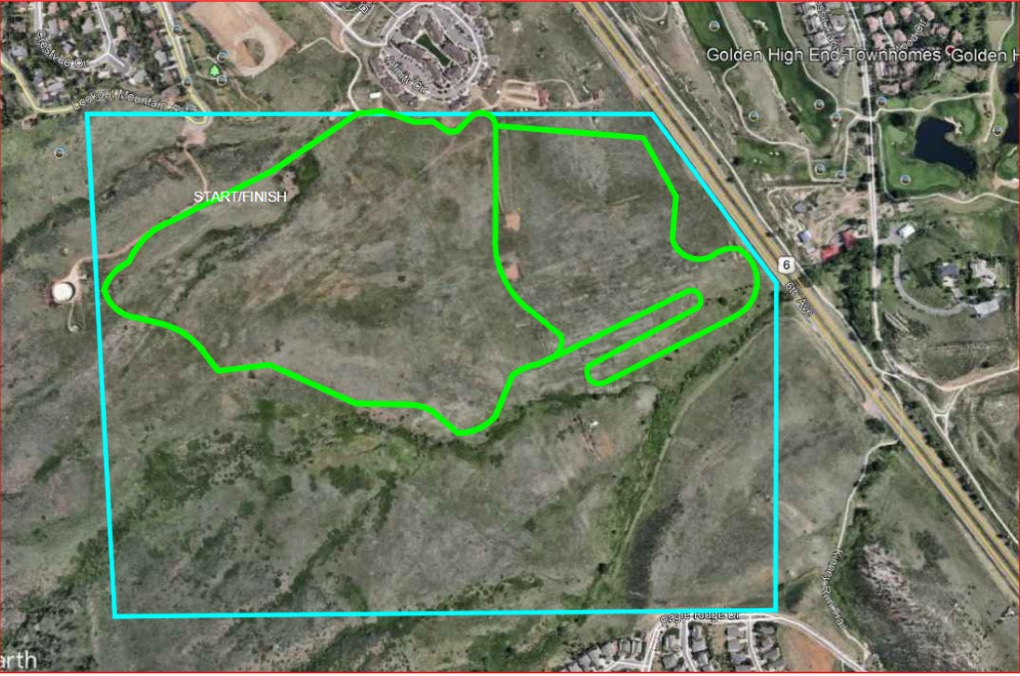
Initial Course Design
Design Solution
The design solution for this project incorporates both the needs of the client and the concerns of the stakeholders who will be using the project site. Both a 2-kilometer and 3-kilometer loop were designed to the NCAA standards and incorporated design standards from the Jefferson County Transportation Design and Construction Manual. By utilizing highway construction standards, the course has been designed to exhibit proper drainage and provide an even running surface to mitigate injuries that could occur while running on a dirt path. Additionally, the use of highway construction manuals has ensured that the turns of the course are gradual, with each curve having a radius greater than 25 feet. This makes sure that runners will not have to make sharp cuts while running, which provides a pleasant running experience while also reducing the chance of injuries. The course was also designed to avoid any no-build areas where current stakeholders utilize the field for academic instruction. Both the 2K and 3K loops only cross into these no-build zones when absolutely necessary.
Meeting the required NCAA standards guarantees that the course can hold all levels of cross-country meets, from conference level to regional championships. The start/finish line of the course has been designed to include up to 30 team boxes, which is the typical number of teams competing in a NCAA regional championship. The design also considered the number of spectators that would be present at the regional championship meet and used that as a basis for the design of the public access plan. The public access plan lays out specific areas for spectators, runners, and coaches to be stationed, which is necessary because of the large, no-build areas of the site that cannot even have foot traffic in them. The design solution also proposes signage designs for kilometer markers on the course, giving runners a clear visual of the distance they have travelled from the start/finish line. Finally, the design ensures that vertical slopes on the course do not exceed 15%, and that the course travels over a diverse set of terrain, so that all runners using the course for competition or for recreation have a challenging but not overly exhausting running experience.
The construction documents can be seen below:
Next Steps
For the next steps, our team recommends that this project be handed off to another senior design team next fall. Although we created a functional course, there were constructability concerns in regards to the high cut and fill cost of the site, potential disturbance of the academic equipment, and access of heavy equipment to the field. Also, just recently in 2021, the team was made aware of an approved mountain bike course to be built in the northwest section of the field that will interfere with the start/finish line of the proposed course. The new team will have time to take this new information into consideration and alter the design accordingly. We believe with another iteration of the course will improve the constructability concerns that were brought to our attention and lower the overall cost and duration of this project.
Meet the Team
Alexa Hampton
 Civil Engineering student from Denver, Colorado.
Civil Engineering student from Denver, Colorado.
I first became interested in Civil Engineering from my dad and grandpa, who were both Civil Engineers. My first internship was more on the Environmental Engineering side where I worked on water projects including both design and construction aspects. Upon graduation, I will be joining the solar team at Kimley-Horn in their Las Vegas office where I will be doing design consulting.
Brenden Posey
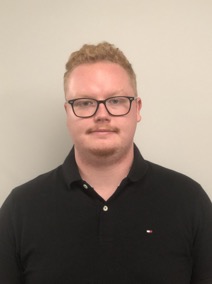 Civil Engineering student from Westminster, Colorado.
Civil Engineering student from Westminster, Colorado.
I went to a STEM high school which generated my interest in engineering. I have always lived in Colorado and would like to stay as long as possible. I have worked for Denver Water as a Construction Management Engineer and am currently working for Manhard Consulting in Greenwood Village who I’ll be joining full time after graduation.
Christian Mueller
 Civil Engineering student from Broomfield, Colorado.
Civil Engineering student from Broomfield, Colorado.
I have a younger brother named Nathan that is a freshman at Colorado State University. In my first couple years of college, I had jobs as a fencing contractor and electrician’s apprentice and both were on construction sites. These jobs made me realize my passion for the construction industry and decide to play a bigger role in such projects as a Civil Engineer. Last summer, I was an intern for MWH Constructors and worked on a wastewater treatment plant in Denver, CO. I gained useful experience on the engineering side of construction as well as how to manage sub-contractors. Next fall, I will be pursuing a master’s degree at Mines in Engineering and Technology Management which I plan to finish in May 2022.
Dartagnan McLean
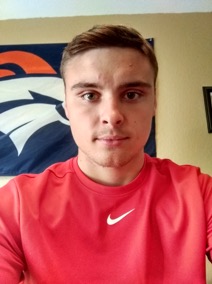 Civil Engineering Student from Fruita, Colorado.
Civil Engineering Student from Fruita, Colorado.
I have three brothers: a younger brother, a twin brother, and an older brother who also went to Colorado School of Mines. My work experience includes working for the City of Fruita as part of their road and bridge crew. With that, I helped with all aspects of road improvement such as chip sealing, patching, and fog coating. I have also worked at Vortex Engineering, a land development company in Grand Junction, Colorado.
Dominic Hathaway
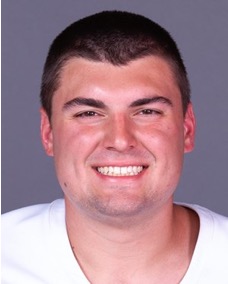 Civil Engineering Student from Traverse City, Michigan.
Civil Engineering Student from Traverse City, Michigan.
I grew up in the world of residential construction and am the 4th generation to begin my career in the construction industry. I’ve worked on a job site basically since I could hold a shovel and have spent my past summers as a carpenter building custom homes back in Michigan. Upon graduation, I will be joining McCarthy Building Companies Southern California Region where I will be working as a project engineer in the parking structures field.
Jordan Turnquest
 Civil Engineering student from Houston, Texas.
Civil Engineering student from Houston, Texas.
My sister and I are second-generation college students. My father is a surgeon from the Bahamas and my mother is an IT manager from Texas. My sister graduated from The University of Texas and is currently pursuing a PhD from the University of Houston. I have worked in a design consulting firm where I dealt with building enclosures, performance testing and forensic assessments. This summer, I am going into the construction side of engineering through an internship with Ryan Companies where I will pursue a career in project management. I will graduate this coming December.
